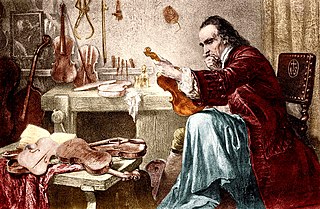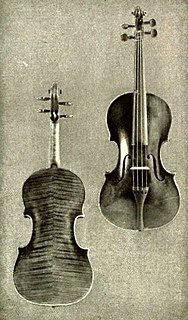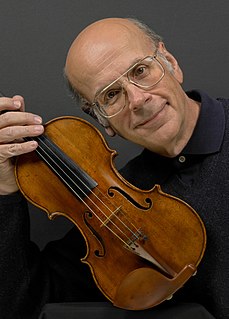Related Research Articles

Antonio Stradivari was an Italian luthier and a craftsman of string instruments such as violins, cellos, guitars, violas and harps. The Latinized form of his surname, Stradivarius, as well as the colloquial Strad are terms often used to refer to his instruments. It is estimated that Stradivari produced 1,116 instruments, of which 960 were violins. Around 650 instruments survive, including 450 to 512 violins. His instruments are considered some of the finest ever made, and are extremely valuable collector's items.

A Stradivarius is one of the violins, violas, cellos and other string instruments built by members of the Italian family Stradivari, particularly Antonio Stradivari, during the 17th and 18th centuries. They are considered some of the finest instruments ever made, and are extremely valuable collectors items.
The Guarneri, often referred to in the Latinized form Guarnerius, is the family name of a group of distinguished luthiers from Cremona in Italy in the 17th and 18th centuries, whose standing is considered comparable to those of the Amati and Stradivari families.

Jean-Baptiste Vuillaume was a French luthier, businessman, inventor and winner of many awards. His workshop made over 3,000 instruments.

The Lipinski Stradivarius is an antique violin constructed in 1715 by the Italian luthier Antonio Stradivari of Cremona, during Stradivari's "golden period" between 1700 and 1725. There are fewer than 650 extant Stradivarius violins in the world today, and the Lipinski is considered to be a particularly fine example. In 2012, it was appraised at US$5 million.

The Stradivari Society is a philanthropic organization based in Chicago, Illinois, best known for its arranging deals between owners of antique string instruments such as those made by luthiers Antonio Stradivari and Giuseppe Guarneri, for use by talented musicians and performers. The Stradivari Society does not hold title to the instruments.

The violin, viola and cello were first built in the early 16th century, in Italy. The earliest evidence for their existence is in paintings by Gaudenzio Ferrari from the 1530s, though Ferrari's instruments had only three strings. The Academie musicale, a treatise written in 1556 by Philibert Jambe de Fer, gives a clear description of the violin family much as we know it today.

Bartolomeo Giuseppe "del Gesù" Guarneri was an Italian luthier from the Guarneri family of Cremona. He rivals Antonio Stradivari (1644–1737) with regard to the respect and reverence accorded his instruments, and for many prominent players and collectors his instruments are the most coveted of all. Instruments made by Guarneri are often referred to as Del Gesùs.
Joseph Curtin is an American contemporary violinmaker who lives in Ann Arbor, Michigan. He is recognised as one of the world's greatest violinmakers.
The Markees is a violin made by Italian luthier Antonio Stradivari of Cremona. It was created in 1701. The violin is owned by the Music Chamber of Hong Kong, having been purchased in 2004 from a professor at the Juilliard School of Music. It was loaned to Leung Kin-fung, concertmaster of the Hong Kong Philharmonic, but has been returned.

David Laurie - was a distinguished 19th century violin collector.
Stewart Pollens is an expert on historical musical instruments. His work includes restoration, analysis, and scholarly publication; and it embraces keyboard instruments as well as historical stringed instruments such as the violin and cello. Andrew Manze has called him "one of the world’s foremost authorities on musical instruments."

Tarisio Auctions is a web-based auction house that specializes in string instruments and bows. Founded in 1999 with locations in New York and London, its online auctions provide a global marketplace for musical instrument sales.

David L. Fulton is a private collector of Cremonese instruments. Born in 1944, he grew up in Eugene, Oregon, playing the violin from an early age. He studied mathematics at the University of Chicago, and was concertmaster of the University of Chicago Symphony while he was there.
"Player preferences among new and old violins" is a scholarly paper published in the Proceedings of the National Academy of Sciencesin January 2012. It describes a double-blind study in which researcher Claudia Fritz of the Pierre and Marie Curie University and violinmaker Joseph Curtin asked judges and participants at the 2010 International Violin Competition of Indianapolis to choose the violin they preferred from a pool of three modern violins, two Stradivariuses, and one Guarneri 'del Gesu'. Fritz and Curtin found that participants most frequently chose a new rather than old violin. This result—which contradicts widespread belief among violinists that the best 16th and 17th century Golden Age violins are superior to the best modern ones—attracted significant media attention.

Visit to Minotaur or is a Soviet TV serial detective film, based on the eponymous novel by the Vayner Brothers, shot by the director Eldor Urazbayev in 1987.

The Violin Museum is a musical instrument museum located in Cremona. The museum is best known for its collection of stringed instruments that includes violins, violas, cellos and double basses crafted by renowned luthiers, including Antonio Stradivari and Giuseppe Guarneri del Gesù.

The Le Brun Stradivarius of 1712 is a violin made by Italian luthier Antonio Stradivari of Cremona (1644–1737). It is the only violin from Stradivari’s golden period known to have been owned and played by the violinist Niccolò Paganini. When sold at a Sotheby's auction in London in November 2001 it achieved one of the highest prices ever paid for a violin at auction, and became the most expensive instrument in Europe.
The Da Vinci, ex-Seidel Stradivarius is a violin made by Antonio Stradivari of Cremona, Italy in 1714.
References
- ↑ "Nagyvary, Joseph". Texas A&M University.
- ↑ Robert Uhlig (31 March 2001). "Stradivari 'Owes it All to Worms'". The Telegraph. Archived from the original on 13 September 2004. Retrieved 2007-08-20.
- ↑ This applies only to the maple, a relatively less important acoustical contributor to violin-family instruments. Spruce for Stradivari's instruments was not likely to have been brought through Venice, as it came from Northern Italy and parts further North. As such there would have been no need for such a round-about journey.
- ↑ Joseph Nagyvary; Renald N. Guillemette; Clifford H. Spiegelman (2009). "Mineral Preservatives in the Wood of Stradivari and Guarneri". PLOS ONE. 4 (1): e4245. doi: 10.1371/journal.pone.0004245 . PMC 2621340 . PMID 19158950.
- ↑ Kathleen Phillips (22 Sep 2003). "Violin Duel a Draw for Antique Stradivarius, New Instrument". AGNews. Texas A&M University. Archived from the original on 3 October 2003. Retrieved 2008-02-24.